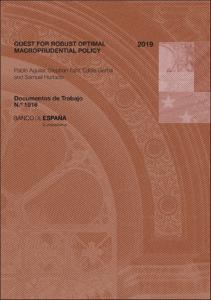Quest for robust optimal macroprudential policy
Autor
Fecha de publicación
19-jun-2019
Descripción física
48 p.
Resumen
Este artículo propone una nueva aproximación al análisis de las políticas macroprudenciales
basado en el bienestar de la economía. En línea con Gerba (2017), fijamos una función
de bienestar con criterios de primer y segundo orden ligados a la utilidad agregada de
la economía para determinar los beneficios de distintas reglas macroprudenciales en la
zona del euro. Esta propuesta es evaluada en el marco del modelo de Crec et al. (2015).
Los resultados muestran que el nivel de capital óptimo es de un 15,6 %, 2,4 puntos
porcentuales por encima de la media del período 2001-2015. Situándose los requisitos
de capital en su nivel óptimo se reduce signifi cativamente la volatilidad de la economía,
a la vez que aumenta el nivel de bienestar a largo plazo, aun siendo un instrumento
invariante en el tiempo. Dicho de otro modo, bajo el nivel óptimo de capital el porcentaje
de quiebras bancarias hubiera sido 3,5 puntos porcentuales menor, y el crédito y el PIB,
un 5 % y un 0,8 % mayores respectivamente, durante la crisis de 2011-2013. Además, con
el uso de una función de pérdidas consistente con el modelo, encontramos que la regla
para el colchón de capital contracíclico (CCyB) depende de si la economía se encuentra
en su nivel óptimo de capital o no. Condicionado a esto último, los resultados sugieren
que el CCyB óptimo debe responder a movimientos en el crédito y en los diferenciales
hipotecarios. Además, las ganancias en términos de bienestar resultan mayores cuando
la determinación de ambas herramientas macroprudenciales es conjunta gracias a las
sinergias que se generan.
This paper contributes by providing a new approach to study optimal macroprudential policies based on economy wide welfare. Following Gerba (2017), we pin down a welfare function based on a fi rst-and second order approximation of the aggregate utility in the economy and use it to determine the merits of different macroprudential rules for Euro Area. With the aim to test this framework, we apply it to the model of Clerc et al. (2015). We fi nd that the optimal level of capital is 15.6 percent, or 2.4 percentage points higher than the 2001-2015 value. Optimal capital reduces signifi cantly the volatility of the economy while increasing somewhat the total level of welfare in steady state, even with a time-invariant instrument. Expressed differently, bank default rates would have been 3.5 percentage points lower while credit and GDP 5% and 0.8% higher had optimal capital level been in place during the 2011-2013 crisis. Further, using a model-consistent loss function, we fi nd that the optimal Countercyclical Capital Buffer (CCyB) rule depends on whether observed or optimal capital levels are already in place. Conditional on optimal capital level, optimal CCyB rule should respond to movements in total credit and mortgage lending spreads. Gains in welfare from optimal combination of instruments is higher than the sum of their individual effects due to synergies and positive mutual spillovers.
This paper contributes by providing a new approach to study optimal macroprudential policies based on economy wide welfare. Following Gerba (2017), we pin down a welfare function based on a fi rst-and second order approximation of the aggregate utility in the economy and use it to determine the merits of different macroprudential rules for Euro Area. With the aim to test this framework, we apply it to the model of Clerc et al. (2015). We fi nd that the optimal level of capital is 15.6 percent, or 2.4 percentage points higher than the 2001-2015 value. Optimal capital reduces signifi cantly the volatility of the economy while increasing somewhat the total level of welfare in steady state, even with a time-invariant instrument. Expressed differently, bank default rates would have been 3.5 percentage points lower while credit and GDP 5% and 0.8% higher had optimal capital level been in place during the 2011-2013 crisis. Further, using a model-consistent loss function, we fi nd that the optimal Countercyclical Capital Buffer (CCyB) rule depends on whether observed or optimal capital levels are already in place. Conditional on optimal capital level, optimal CCyB rule should respond to movements in total credit and mortgage lending spreads. Gains in welfare from optimal combination of instruments is higher than the sum of their individual effects due to synergies and positive mutual spillovers.
Publicado en
Documentos de Trabajo / Banco de España, 1916
Materias
Política macroprudencial óptima; Análisis de bienestar; Estabilidad financiera; Modelos de equilibrio general; Optimal policy; Global welfare analysis; Financial stability; Financial DSGE model; Macroprudential policy; Instituciones crediticias de depósito; Regulación y supervisión de instituciones financieras; Bancos centrales y otras autoridades monetarias; Zona euro
Aparece en las colecciones:












